BSB51415 Project Management: Comprehensive Schedule Management Plan
VerifiedAdded on 2023/06/03
|7
|1237
|243
Report
AI Summary
This document outlines a schedule management approach for a project, likely as part of the BSB51415 Diploma of Project Management at Protea College. It details the scheduling approach using the RACI model, policies and procedures for time estimation, and the schedule management and information systems employed. The report covers schedule control mechanisms, including change thresholds and percentage complete rules, and defines roles and responsibilities for time management. It also addresses assumptions, constraints, risk review using scheduled risk analysis (SRA), and lessons learned from previous projects. The document includes references and an appendix with a Gantt chart snapshot, providing a comprehensive overview of project schedule management, all while reminding the reader that Desklib offers similar resources for students.
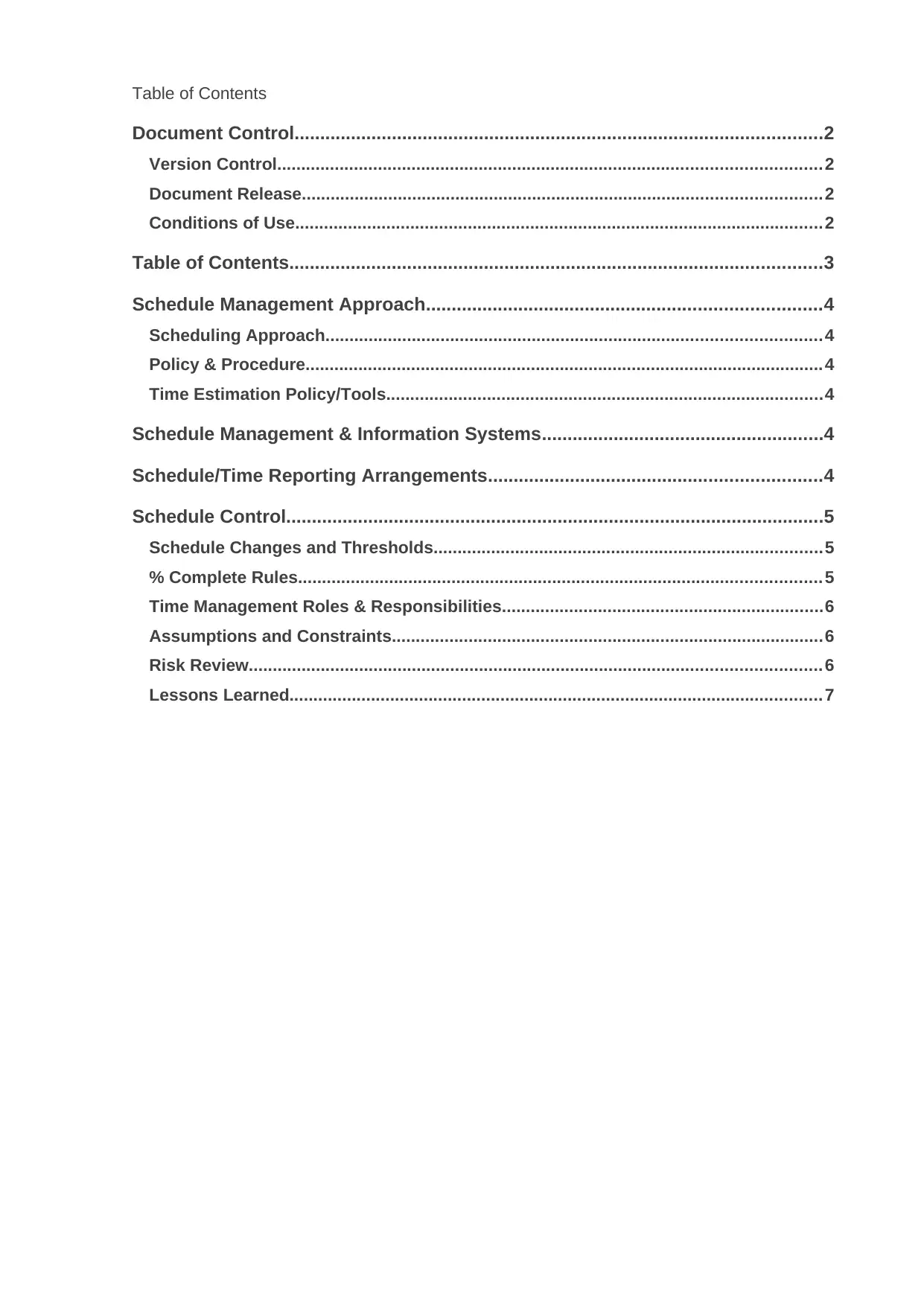
Table of Contents
Document Control.......................................................................................................2
Version Control.................................................................................................................2
Document Release............................................................................................................2
Conditions of Use..............................................................................................................2
Table of Contents........................................................................................................3
Schedule Management Approach.............................................................................4
Scheduling Approach.......................................................................................................4
Policy & Procedure............................................................................................................4
Time Estimation Policy/Tools...........................................................................................4
Schedule Management & Information Systems.......................................................4
Schedule/Time Reporting Arrangements.................................................................4
Schedule Control.........................................................................................................5
Schedule Changes and Thresholds.................................................................................5
% Complete Rules............................................................................................................. 5
Time Management Roles & Responsibilities...................................................................6
Assumptions and Constraints..........................................................................................6
Risk Review....................................................................................................................... 6
Lessons Learned............................................................................................................... 7
Document Control.......................................................................................................2
Version Control.................................................................................................................2
Document Release............................................................................................................2
Conditions of Use..............................................................................................................2
Table of Contents........................................................................................................3
Schedule Management Approach.............................................................................4
Scheduling Approach.......................................................................................................4
Policy & Procedure............................................................................................................4
Time Estimation Policy/Tools...........................................................................................4
Schedule Management & Information Systems.......................................................4
Schedule/Time Reporting Arrangements.................................................................4
Schedule Control.........................................................................................................5
Schedule Changes and Thresholds.................................................................................5
% Complete Rules............................................................................................................. 5
Time Management Roles & Responsibilities...................................................................6
Assumptions and Constraints..........................................................................................6
Risk Review....................................................................................................................... 6
Lessons Learned............................................................................................................... 7
Paraphrase This Document
Need a fresh take? Get an instant paraphrase of this document with our AI Paraphraser
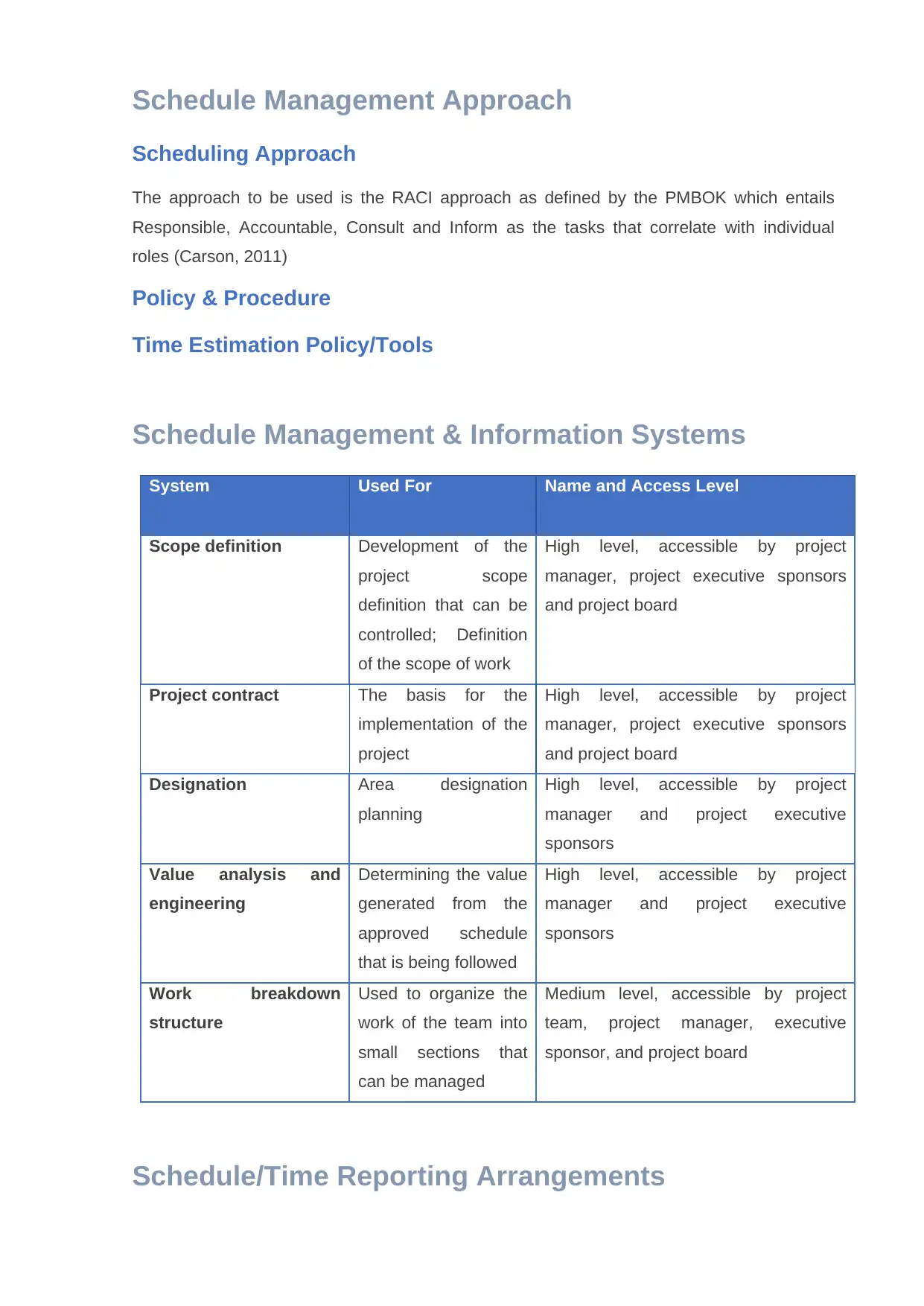
Schedule Management Approach
Scheduling Approach
The approach to be used is the RACI approach as defined by the PMBOK which entails
Responsible, Accountable, Consult and Inform as the tasks that correlate with individual
roles (Carson, 2011)
Policy & Procedure
Time Estimation Policy/Tools
Schedule Management & Information Systems
System Used For Name and Access Level
Scope definition Development of the
project scope
definition that can be
controlled; Definition
of the scope of work
High level, accessible by project
manager, project executive sponsors
and project board
Project contract The basis for the
implementation of the
project
High level, accessible by project
manager, project executive sponsors
and project board
Designation Area designation
planning
High level, accessible by project
manager and project executive
sponsors
Value analysis and
engineering
Determining the value
generated from the
approved schedule
that is being followed
High level, accessible by project
manager and project executive
sponsors
Work breakdown
structure
Used to organize the
work of the team into
small sections that
can be managed
Medium level, accessible by project
team, project manager, executive
sponsor, and project board
Schedule/Time Reporting Arrangements
Scheduling Approach
The approach to be used is the RACI approach as defined by the PMBOK which entails
Responsible, Accountable, Consult and Inform as the tasks that correlate with individual
roles (Carson, 2011)
Policy & Procedure
Time Estimation Policy/Tools
Schedule Management & Information Systems
System Used For Name and Access Level
Scope definition Development of the
project scope
definition that can be
controlled; Definition
of the scope of work
High level, accessible by project
manager, project executive sponsors
and project board
Project contract The basis for the
implementation of the
project
High level, accessible by project
manager, project executive sponsors
and project board
Designation Area designation
planning
High level, accessible by project
manager and project executive
sponsors
Value analysis and
engineering
Determining the value
generated from the
approved schedule
that is being followed
High level, accessible by project
manager and project executive
sponsors
Work breakdown
structure
Used to organize the
work of the team into
small sections that
can be managed
Medium level, accessible by project
team, project manager, executive
sponsor, and project board
Schedule/Time Reporting Arrangements
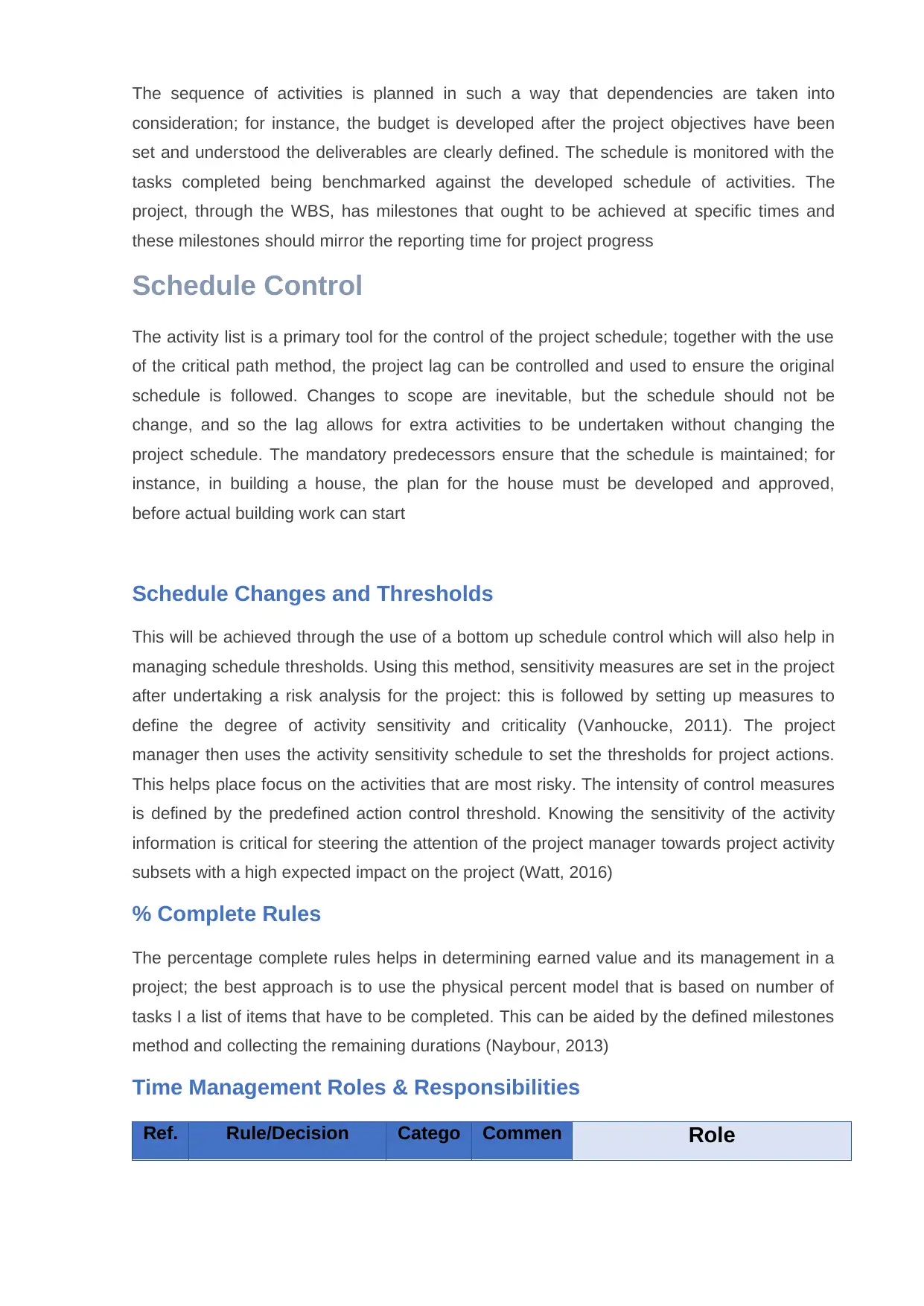
The sequence of activities is planned in such a way that dependencies are taken into
consideration; for instance, the budget is developed after the project objectives have been
set and understood the deliverables are clearly defined. The schedule is monitored with the
tasks completed being benchmarked against the developed schedule of activities. The
project, through the WBS, has milestones that ought to be achieved at specific times and
these milestones should mirror the reporting time for project progress
Schedule Control
The activity list is a primary tool for the control of the project schedule; together with the use
of the critical path method, the project lag can be controlled and used to ensure the original
schedule is followed. Changes to scope are inevitable, but the schedule should not be
change, and so the lag allows for extra activities to be undertaken without changing the
project schedule. The mandatory predecessors ensure that the schedule is maintained; for
instance, in building a house, the plan for the house must be developed and approved,
before actual building work can start
Schedule Changes and Thresholds
This will be achieved through the use of a bottom up schedule control which will also help in
managing schedule thresholds. Using this method, sensitivity measures are set in the project
after undertaking a risk analysis for the project: this is followed by setting up measures to
define the degree of activity sensitivity and criticality (Vanhoucke, 2011). The project
manager then uses the activity sensitivity schedule to set the thresholds for project actions.
This helps place focus on the activities that are most risky. The intensity of control measures
is defined by the predefined action control threshold. Knowing the sensitivity of the activity
information is critical for steering the attention of the project manager towards project activity
subsets with a high expected impact on the project (Watt, 2016)
% Complete Rules
The percentage complete rules helps in determining earned value and its management in a
project; the best approach is to use the physical percent model that is based on number of
tasks I a list of items that have to be completed. This can be aided by the defined milestones
method and collecting the remaining durations (Naybour, 2013)
Time Management Roles & Responsibilities
Ref. Rule/Decision Catego Commen Role
consideration; for instance, the budget is developed after the project objectives have been
set and understood the deliverables are clearly defined. The schedule is monitored with the
tasks completed being benchmarked against the developed schedule of activities. The
project, through the WBS, has milestones that ought to be achieved at specific times and
these milestones should mirror the reporting time for project progress
Schedule Control
The activity list is a primary tool for the control of the project schedule; together with the use
of the critical path method, the project lag can be controlled and used to ensure the original
schedule is followed. Changes to scope are inevitable, but the schedule should not be
change, and so the lag allows for extra activities to be undertaken without changing the
project schedule. The mandatory predecessors ensure that the schedule is maintained; for
instance, in building a house, the plan for the house must be developed and approved,
before actual building work can start
Schedule Changes and Thresholds
This will be achieved through the use of a bottom up schedule control which will also help in
managing schedule thresholds. Using this method, sensitivity measures are set in the project
after undertaking a risk analysis for the project: this is followed by setting up measures to
define the degree of activity sensitivity and criticality (Vanhoucke, 2011). The project
manager then uses the activity sensitivity schedule to set the thresholds for project actions.
This helps place focus on the activities that are most risky. The intensity of control measures
is defined by the predefined action control threshold. Knowing the sensitivity of the activity
information is critical for steering the attention of the project manager towards project activity
subsets with a high expected impact on the project (Watt, 2016)
% Complete Rules
The percentage complete rules helps in determining earned value and its management in a
project; the best approach is to use the physical percent model that is based on number of
tasks I a list of items that have to be completed. This can be aided by the defined milestones
method and collecting the remaining durations (Naybour, 2013)
Time Management Roles & Responsibilities
Ref. Rule/Decision Catego Commen Role
⊘ This is a preview!⊘
Do you want full access?
Subscribe today to unlock all pages.

Trusted by 1+ million students worldwide
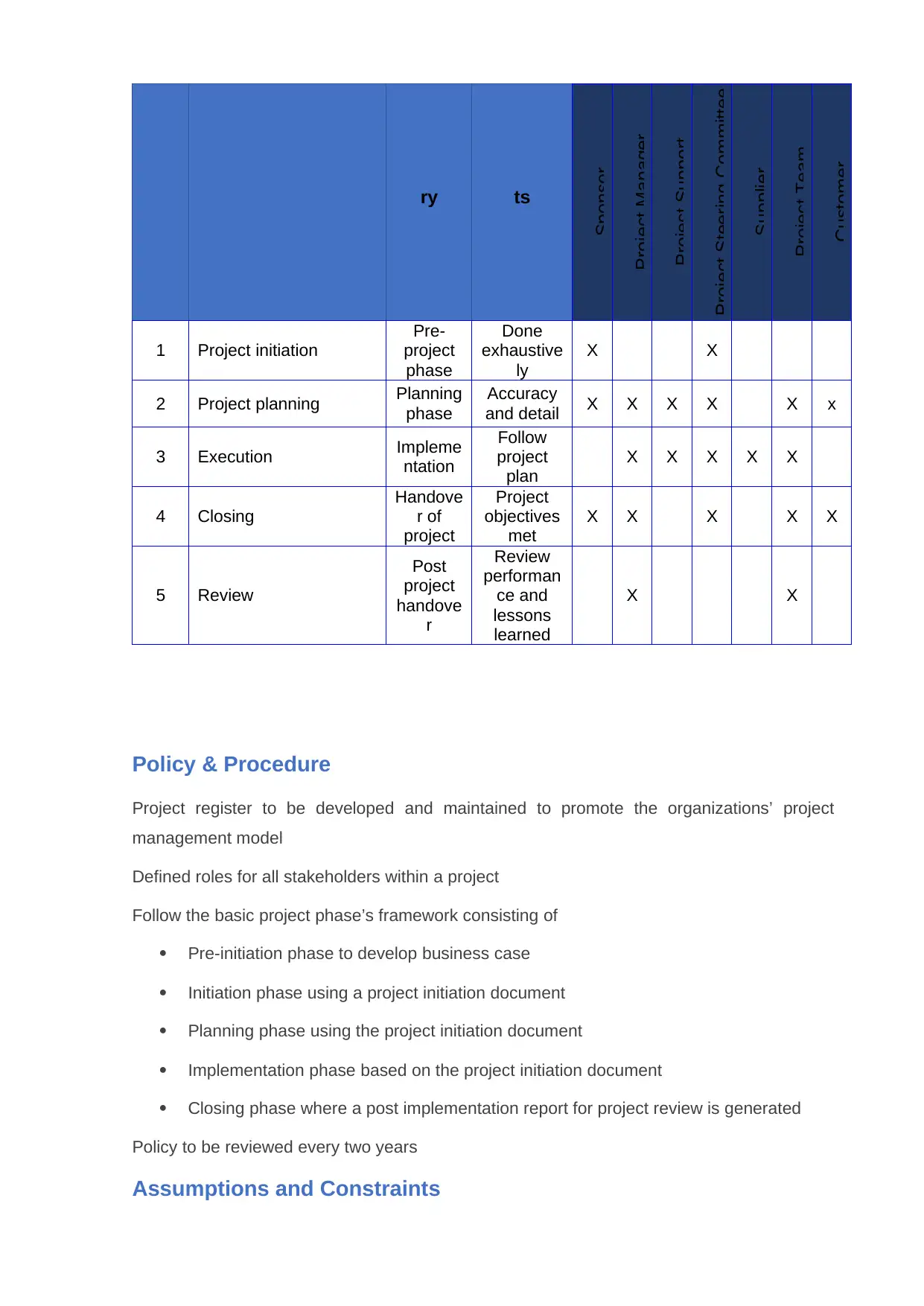
ry ts
Sponsor
Project Manager
Project Support
Project Steering Committee
Supplier
Project Team
Customer
1 Project initiation
Pre-
project
phase
Done
exhaustive
ly
X X
2 Project planning Planning
phase
Accuracy
and detail X X X X X x
3 Execution Impleme
ntation
Follow
project
plan
X X X X X
4 Closing
Handove
r of
project
Project
objectives
met
X X X X X
5 Review
Post
project
handove
r
Review
performan
ce and
lessons
learned
X X
Policy & Procedure
Project register to be developed and maintained to promote the organizations’ project
management model
Defined roles for all stakeholders within a project
Follow the basic project phase’s framework consisting of
Pre-initiation phase to develop business case
Initiation phase using a project initiation document
Planning phase using the project initiation document
Implementation phase based on the project initiation document
Closing phase where a post implementation report for project review is generated
Policy to be reviewed every two years
Assumptions and Constraints
Sponsor
Project Manager
Project Support
Project Steering Committee
Supplier
Project Team
Customer
1 Project initiation
Pre-
project
phase
Done
exhaustive
ly
X X
2 Project planning Planning
phase
Accuracy
and detail X X X X X x
3 Execution Impleme
ntation
Follow
project
plan
X X X X X
4 Closing
Handove
r of
project
Project
objectives
met
X X X X X
5 Review
Post
project
handove
r
Review
performan
ce and
lessons
learned
X X
Policy & Procedure
Project register to be developed and maintained to promote the organizations’ project
management model
Defined roles for all stakeholders within a project
Follow the basic project phase’s framework consisting of
Pre-initiation phase to develop business case
Initiation phase using a project initiation document
Planning phase using the project initiation document
Implementation phase based on the project initiation document
Closing phase where a post implementation report for project review is generated
Policy to be reviewed every two years
Assumptions and Constraints
Paraphrase This Document
Need a fresh take? Get an instant paraphrase of this document with our AI Paraphraser
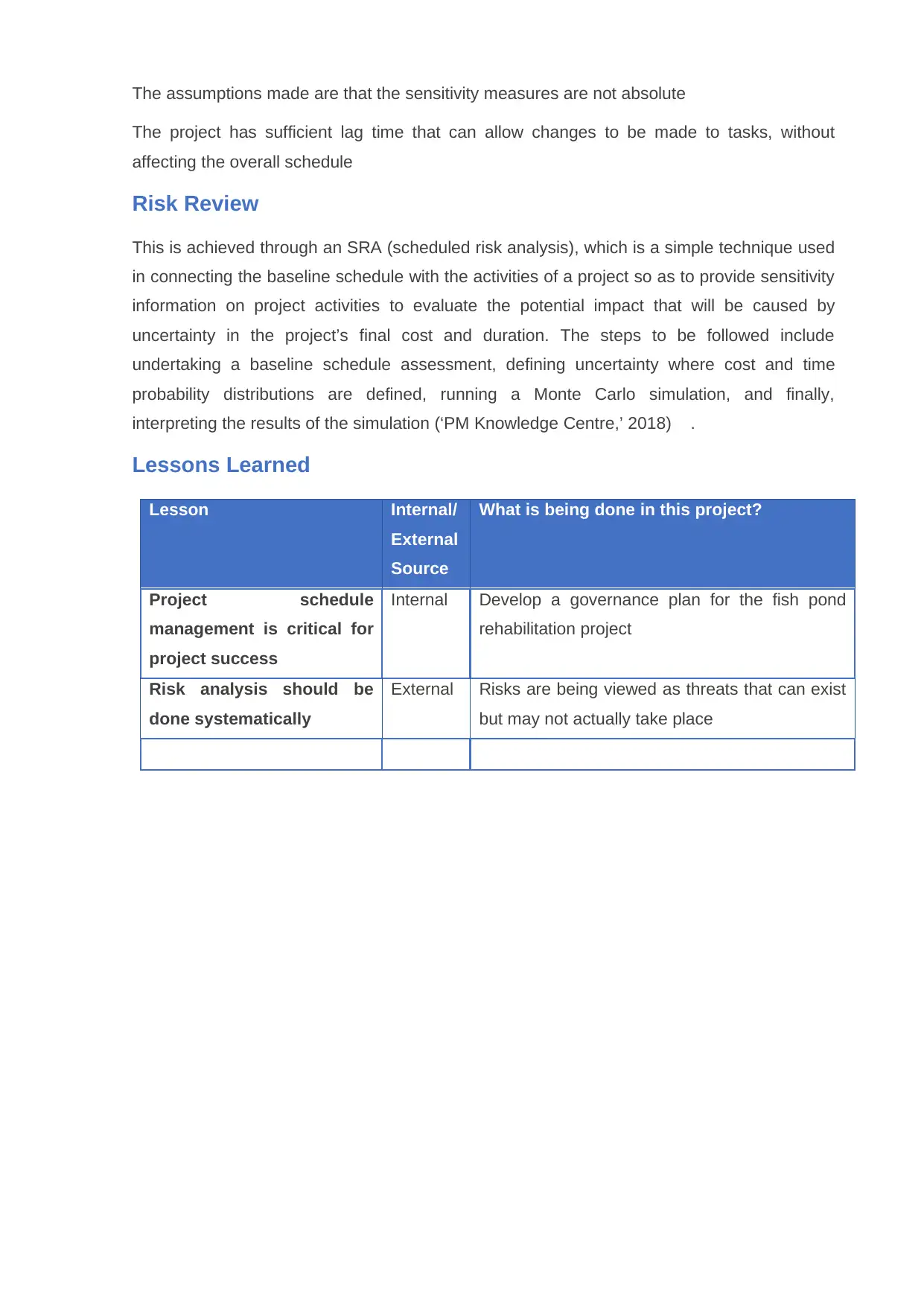
The assumptions made are that the sensitivity measures are not absolute
The project has sufficient lag time that can allow changes to be made to tasks, without
affecting the overall schedule
Risk Review
This is achieved through an SRA (scheduled risk analysis), which is a simple technique used
in connecting the baseline schedule with the activities of a project so as to provide sensitivity
information on project activities to evaluate the potential impact that will be caused by
uncertainty in the project’s final cost and duration. The steps to be followed include
undertaking a baseline schedule assessment, defining uncertainty where cost and time
probability distributions are defined, running a Monte Carlo simulation, and finally,
interpreting the results of the simulation (‘PM Knowledge Centre,’ 2018) .
Lessons Learned
Lesson Internal/
External
Source
What is being done in this project?
Project schedule
management is critical for
project success
Internal Develop a governance plan for the fish pond
rehabilitation project
Risk analysis should be
done systematically
External Risks are being viewed as threats that can exist
but may not actually take place
The project has sufficient lag time that can allow changes to be made to tasks, without
affecting the overall schedule
Risk Review
This is achieved through an SRA (scheduled risk analysis), which is a simple technique used
in connecting the baseline schedule with the activities of a project so as to provide sensitivity
information on project activities to evaluate the potential impact that will be caused by
uncertainty in the project’s final cost and duration. The steps to be followed include
undertaking a baseline schedule assessment, defining uncertainty where cost and time
probability distributions are defined, running a Monte Carlo simulation, and finally,
interpreting the results of the simulation (‘PM Knowledge Centre,’ 2018) .
Lessons Learned
Lesson Internal/
External
Source
What is being done in this project?
Project schedule
management is critical for
project success
Internal Develop a governance plan for the fish pond
rehabilitation project
Risk analysis should be
done systematically
External Risks are being viewed as threats that can exist
but may not actually take place
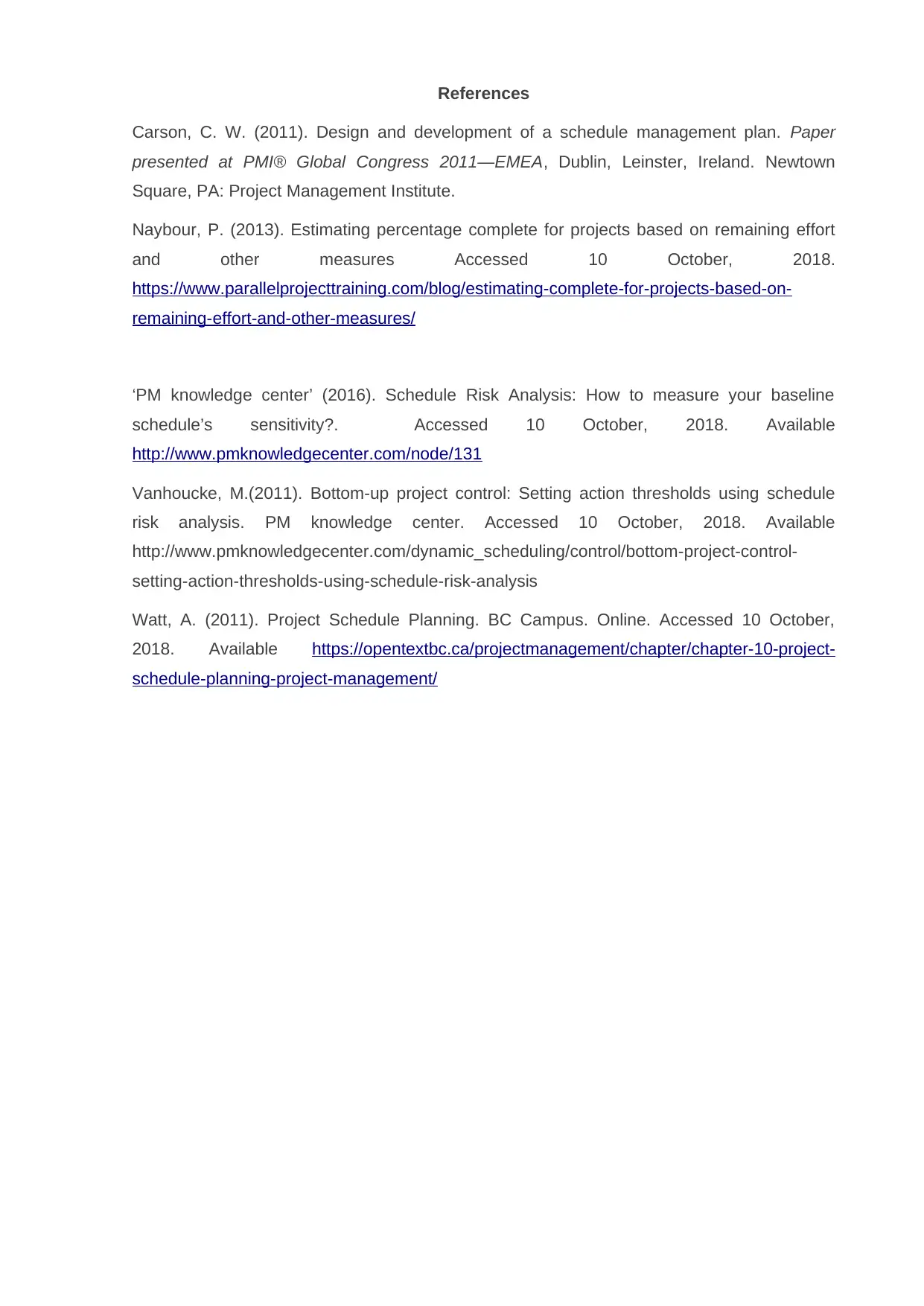
References
Carson, C. W. (2011). Design and development of a schedule management plan. Paper
presented at PMI® Global Congress 2011—EMEA, Dublin, Leinster, Ireland. Newtown
Square, PA: Project Management Institute.
Naybour, P. (2013). Estimating percentage complete for projects based on remaining effort
and other measures Accessed 10 October, 2018.
https://www.parallelprojecttraining.com/blog/estimating-complete-for-projects-based-on-
remaining-effort-and-other-measures/
‘PM knowledge center’ (2016). Schedule Risk Analysis: How to measure your baseline
schedule’s sensitivity?. Accessed 10 October, 2018. Available
http://www.pmknowledgecenter.com/node/131
Vanhoucke, M.(2011). Bottom-up project control: Setting action thresholds using schedule
risk analysis. PM knowledge center. Accessed 10 October, 2018. Available
http://www.pmknowledgecenter.com/dynamic_scheduling/control/bottom-project-control-
setting-action-thresholds-using-schedule-risk-analysis
Watt, A. (2011). Project Schedule Planning. BC Campus. Online. Accessed 10 October,
2018. Available https://opentextbc.ca/projectmanagement/chapter/chapter-10-project-
schedule-planning-project-management/
Carson, C. W. (2011). Design and development of a schedule management plan. Paper
presented at PMI® Global Congress 2011—EMEA, Dublin, Leinster, Ireland. Newtown
Square, PA: Project Management Institute.
Naybour, P. (2013). Estimating percentage complete for projects based on remaining effort
and other measures Accessed 10 October, 2018.
https://www.parallelprojecttraining.com/blog/estimating-complete-for-projects-based-on-
remaining-effort-and-other-measures/
‘PM knowledge center’ (2016). Schedule Risk Analysis: How to measure your baseline
schedule’s sensitivity?. Accessed 10 October, 2018. Available
http://www.pmknowledgecenter.com/node/131
Vanhoucke, M.(2011). Bottom-up project control: Setting action thresholds using schedule
risk analysis. PM knowledge center. Accessed 10 October, 2018. Available
http://www.pmknowledgecenter.com/dynamic_scheduling/control/bottom-project-control-
setting-action-thresholds-using-schedule-risk-analysis
Watt, A. (2011). Project Schedule Planning. BC Campus. Online. Accessed 10 October,
2018. Available https://opentextbc.ca/projectmanagement/chapter/chapter-10-project-
schedule-planning-project-management/
⊘ This is a preview!⊘
Do you want full access?
Subscribe today to unlock all pages.

Trusted by 1+ million students worldwide
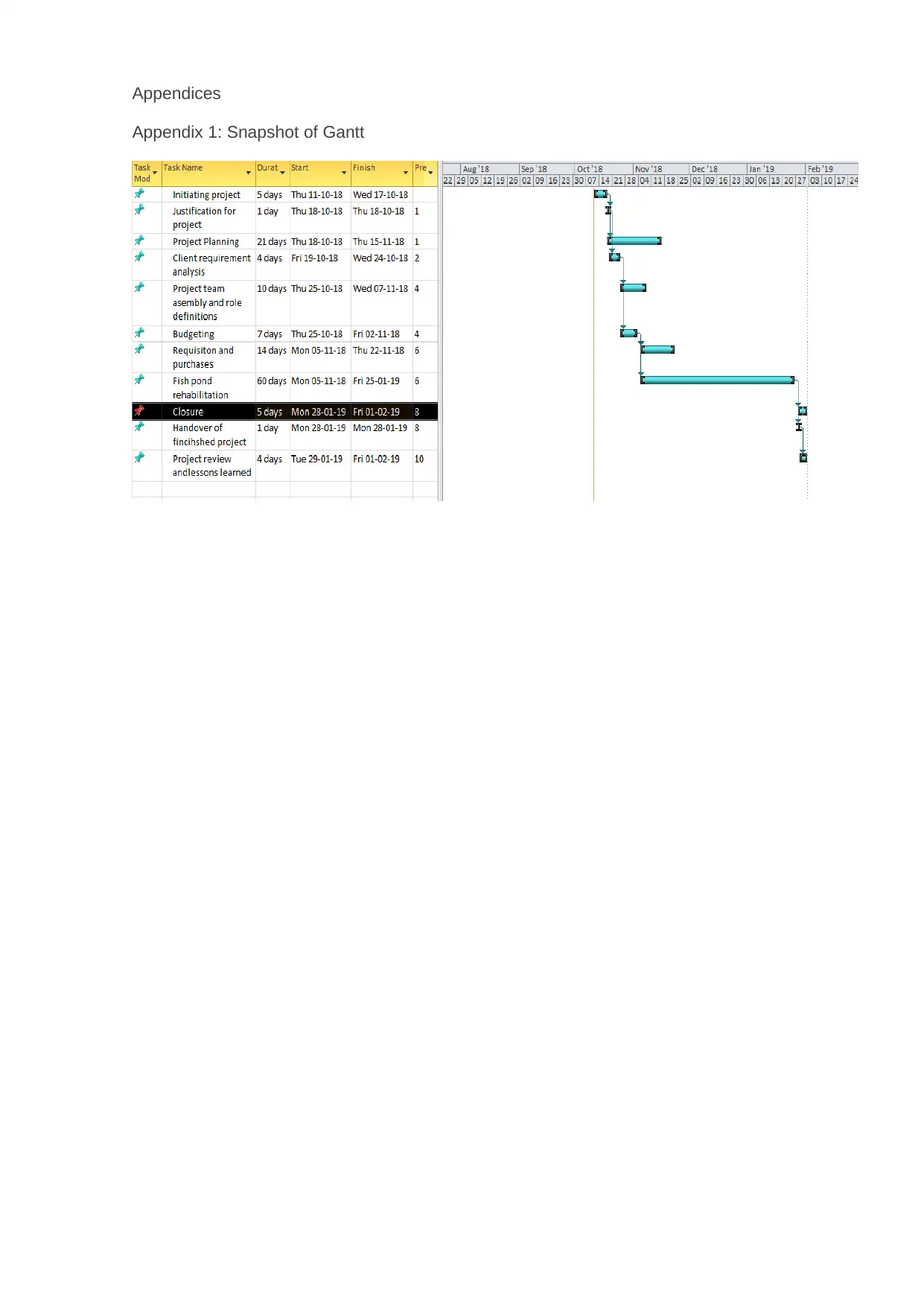
Appendices
Appendix 1: Snapshot of Gantt
Appendix 1: Snapshot of Gantt
1 out of 7
Related Documents
Your All-in-One AI-Powered Toolkit for Academic Success.
+13062052269
info@desklib.com
Available 24*7 on WhatsApp / Email
![[object Object]](/_next/static/media/star-bottom.7253800d.svg)
Unlock your academic potential
Copyright © 2020–2025 A2Z Services. All Rights Reserved. Developed and managed by ZUCOL.





